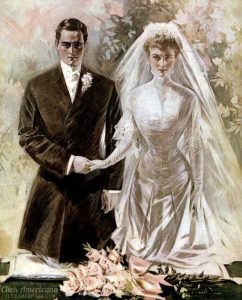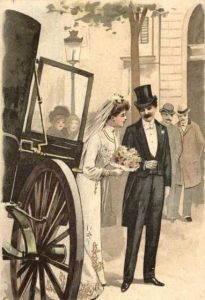Small Home Gazette, Spring 2019
Letter From the Editor: wedding traditions
 Spring is also the season for weddings. If you’re not getting hitched this spring, you may be invited to the weddings of friends or family members. These are occasions filled with tradition, even if many modern ceremonies are quickly adapting those traditions to fit newer concepts of what makes up a family.
Spring is also the season for weddings. If you’re not getting hitched this spring, you may be invited to the weddings of friends or family members. These are occasions filled with tradition, even if many modern ceremonies are quickly adapting those traditions to fit newer concepts of what makes up a family.
But it is nothing new for wedding traditions to change. Take a look at the wedding article in this newsletter for a backward glance at weddings of the bungalow era and before. You may be surprised at what has changed and how some customs seem to be eternal.
One thing that hasn’t changed is the chance that a wedding will go awry. Do a quick online search for “wedding disasters,” and you’ll find scores of shocking (and often hilarious) calamities. Though weddings during the bungalow era were probably tamer, they clearly had pitfalls as well.
The below commentary is from the “In an Editorial Way” section of the March 1907 issue of The Ladies Home Journal.

THERE IS A DONKEY AT ALMOST EVERY WEDDING who perpetuates the inane practice of throwing rice, or shoes, or confetti after the newly-married couple, and nothing seems to have any effect upon this human type of the kingdom of the flapping ears. He is a nuisance in the eyes of the wedding guests; he is a menace to the young couple themselves, and the fact that he clutters up the house where he is a guest never enters his shallow head. His idea of “fun” must prevail at all hazards. But should it be allowed to prevail any longer?
 HAS NOT THIS PERSECUTION OF YOUNG MARRIED COUPLES at the hands of their friends gone far enough? For it is not getting better: if anything, it is growing worse. From the asinine it has degenerated into the vulgar. It is not enough that the bride and bridegroom must be “pelted” by rice, the young couple chased into the cars, and handfuls of confetti poked down the back of the young bride until she is made absurd for strangers to grin at; but the bridal carriage is “decorated” (so-called) with mottoes and streamers until, as in all such cases, it is not a long reach from the purely funny to the vulgar.
HAS NOT THIS PERSECUTION OF YOUNG MARRIED COUPLES at the hands of their friends gone far enough? For it is not getting better: if anything, it is growing worse. From the asinine it has degenerated into the vulgar. It is not enough that the bride and bridegroom must be “pelted” by rice, the young couple chased into the cars, and handfuls of confetti poked down the back of the young bride until she is made absurd for strangers to grin at; but the bridal carriage is “decorated” (so-called) with mottoes and streamers until, as in all such cases, it is not a long reach from the purely funny to the vulgar.
When a carriage is “decorated” with the picture of a stork carrying a baby, and the motto “Not yet, but soon” underneath, we may well ask whether the most sacred things in life are to be made a vaudeville turn and a vulgar jest by a lot of wild young hoydens? It is time that we, who are elders, should see to it—and that with no degree of indecision—that the firm hand of common-sense, yes, of common decency, protect those who are married under our care from the coarseness that is fast becoming part of marriage ceremonies at the hands of the thoughtless young.
We do not meet the case by excusing these lapses on the ground of youthful fun or harmless thoughtlessness. The whole idiotic practice is fast getting beyond those bounds, and before this buffoonery of weddings is allowed to slip further down the easy plane of vulgarity, we should, at the approaching marriage season, squarely put our foot down and call a halt. It has gone far enough: if anything, too far.












